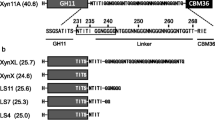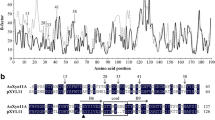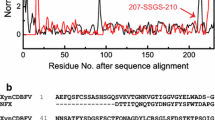Abstract
The amino groups of purified least acidic xylanase (LAX) isomer and carboxyl groups of purified highly acidic xylanase (HAX) isomer fromScopulariopsis sp. were chemically modified, resulting in charge neutralization and reversal. Modification of the second amino group was accompanied by the complete loss of enzyme activity in both the absence and presence of xylose. Multiple alignments of family 10 and 11 xylanases revealed that there is a pair of fully conserved Lys residues only in family 10 members. Xylanase structures from family 10 members showed that one of the conserved Lys residues is found near the active-site cleft that makes an H-bond with the substrate. The LAX and HAX isoenzymes in which one amino and three to four carboxyl groups were modified were subjected to kinetic and thermodynamic characterization. There were no differences in pH optima between the native and modified HAX, but there was a broadening of pH optimum toward the alkaline range for charge-neutralized LAX and a double pH optimum for charge-reversed LAX. TheV max/K m of both modified LAX and HAX decreased relative to the native species. The thermodynamics of xylan hydrolysis showed that the decrease in the catalytic activity of modified LAX enzymes was entropically driven. When compared with native enzyme, the thermostabilities of modified LAX enzymes increased in the presence and decreased in the absence of substrate. The thermodynamics of kinetic stability for modified LAX enzymes revealed that this increase in thermolability was owing to the decrease in ΔH# with a concomitant increase in ΔS# compared with native LAX. The thermostabilities of all the modified HAX species decreased except that of charge-neutralized HAX, whose half-life significantly increased in 50% (v/v) aqueous dioxan. These results suggest that the altered properties of the modified enzymes were a result of the conformational changes brought about by chemical modification.
Similar content being viewed by others
Abbreviations
- HAX:
-
native highly acidic xylanase
- HAX-D:
-
HAX whose thermostability is determined in 50% (v/v) aqueous dioxan
- HAX-N:
-
HAX activated by EDC in presence of methylamine hydrochloride (charge neutralized, − → neutral)
- HAX-N-D:
-
HAX-N whose thermostability is determined in 50% (v/v) aqueous dioxan
- HAX-R:
-
HAX activated by EDC in presence of ethylenediamine dihydrochloride (charge reversed, − → +)
- LAX:
-
native least acidic xylanse
- LAX-N:
-
acetylated LAX (charge neutralized, + → neutral)
- LAX-R:
-
succinylated LAX (charge reversed, + → −)
References
Jeffries, T. W. (1996),Curr. Opin. Biotechnol. 7, 337–342.
Prade, R. A. (1995),Biotech. Genet. Eng. Rev. 13, 100–131.
Collins, T., Gerday, C., and Feller, G. (2005),FEMS Microbiol. Rev. 29, 3–23.
Godfrey, T. and West, S. (2001), inIndustrial Enzymology, Godfrey, T. and West, S., eds., Macmillan, London, pp. 458–459.
Torronen, A., Harkki, A., and Rouvinen, J. (1994),EMBO J. 11, 2493–2501.
Keskar, S. S., Srinivasan, M. C., and Deshpande, V. V. (1990),Biochem. J. 261, 49–55.
Bray, M. R. and Clarke, A. J. (1990),Biochem. J. 270, 91–96.
Chauthaiwale, J. and Rao, M. (1994),Biochim. Biophys. Acta 16, 164–168.
Nath, D. and Rao, M. (2001),Enzyme Microb. Technol. 28, 397–403.
George, S. P. and Rao, M.B. (2001),Eur. J. Biochem. 268, 2881–2888.
Roberge, M., Shareck, F., Morosoli, R., Kluepfel, D., and Dupont, C. (1997),Biochemistry 25, 769–775.
Roberge, M., Shareck, F., Morosoli, R., Kluepfel, D., and Dupont, C. (1998),Protein Eng. 11, 399–404.
George, S. P., Ahmad, A., and Rao, M. B. (2001),Biochem. Biophys. Res. Commun. 282, 48–54.
Afzal, A. J., Ali, S., Latif, F., Rajoka, M. I., and Siddiqui, K. S. (2005),Appl. Biochem. Biotechnol. 120, 51–70.
Wood, W. A. and Bhat, K. M. (1988), in Wood, W. A. and Kellogg, S. T., eds.Methods Enzymol. 160, 87–112.
Coelho, G. D. and Carmona, E. C. (2003),J. Basic Microbiol. 43, 269–277.
Afzal, A. J., Bokhari, S. A., Ahmad, W., Rashid, M. H., Rajoka, M. I., and Siddiqui, K. S. (2000),Biotechnol. Lett. 22, 957–960.
Rashid, M. H., Najmus Saqib, A. A., Rajoka, M. I., and Siddiqui, K. S. (1997),Biotechnol. Techniques 11, 245–247.
Klapper, M. H. and Klotz, I. M. (1972), in Hirs, C. H. W. and Timasheff, S. N., eds.Methods Enzymol. 25, 531–536.
Riordan, J. F. and Vallee, B. L. (1972), in Hirs, C. H. W. and Timasheff, S. N., eds.Methods Enzymol. 25, 494–499.
Lundblad, R. L. (1995), inTechniques in Protein Modification, CRC Press, Boca Raton, FL: pp. 120–129.
Hoare, D. G. and Koshland, D. E. (1967),J. Biol. Chem. 242, 2447–2453.
Carraway, K. L. and Koshland, D. E. Jr. (1972), in Hirs, C. H. W. and Timasheff, S. N., eds.Methods Enzymol.25, 616–623.
Siddiqui, K. S., Loviny-Anderton, T., Rangarajan, M., and Hartley, B. S. (1993),Biochem. J. 296, 685–691.
Rashid, M. H. and Siddiqui, K. S. (1998),Biotechnol. Appl. Biochem. 27, 231–237.
Munch, O. and Tritsch, D. (1990),Biochim. Biophys. Acta 1041, 111–116.
Siddiqui, K. S., Azhar, M. J., Rashid, M. H., and Rajoka, M. I. (1997),Folia Microb.4, 312–318.
Lienhard, G. E. (1973),Science 180, 149–154.
Gonzalez-Villasenor, L. I. and Powers, D. A. (1986),J. Biol. Chem. 25, 11,471–11,477.
Fersht, A. (1985), inEnzyme Structure and Mechanism, W. H. Freeman and Co, New York: pp. 311–346.
Rashid, M. H. and Siddiqui, K. S. (1998),Process Biochem. 33, 109–115.
Siddiqui, K. S., Najmus-Saqib, A. A., Rashid, M. H., and Rajoka, M. I. (1997),Biotechnol. Lett. 19, 325–329.
Siddiqui, K. S., Shemsi, A. M., Anwar, M. A., Rashid, M. H., and Rajoka, M. I. (1999),Enzyme Microb. Technol 24, 599–608.
Notredame, C., Higgins, D., and Heringa, J. (2000),J. Mol. Biol. 302, 205–217.
Siddiqui, K. S., Poljak, A., and Cavicchioli, R. (2004),Cell. Mol. Biol. 50, 657–667.
Siddiqui, K. S. and Cavicchioli, R. (2006),Annu. Rev. Biochem. 75, 403–433.
Chauthaiwal, J. and Rao, M. (1994),Biochim. Biophys. Acta 1204, 164–168.
Ko, E. P., Akatsuka, H., Moriyama, H., et al. (1992),Biochem. J. 288, 117–121.
Torronen, A. and Rouvinen, J. (1995),Biochemistry 34, 847–856.
Nath, D. and Rao, M. (1998),Biochem. Biophys. Res. Commun. 249, 207–212.
Schmidt, A., Schlacher, A., Steiner, W., Schwab, H., and Kratky, C. (1998),Protein Sci. 7, 2081–2088.
Charnock, S. J., Lakey, J. H., Virden, R., et al. (1997),J. Biol. Chem. 272, 2942–2951.
Moreau, A., Shareck, F., Kluepfel, D., and Morosoli, R. (1994),Enzyme Microb. Technol. 16, 420–424.
Kang, M. K., Maeng, P. J., and Rhee, Y. A. (1996),Appl. Environ. Microbiol. 62, 3480–3482.
Muilu, J., Torronen, A., Perakla, M., and Rouvinen, J. (1998),Proteins: Struct. Function Genet. 31, 434–444.
Torronen, A. and Rouvinen, J. (1997),J. Biotechnol. 57, 137–139.
Roberge, M., Dupont, C., Morosoli, R., Shareck, F., and Kluepfel, D. (1997),Protein Eng. 10, 399–403.
Inoue, M., Yamada, H., Hashimoto, Y., et al. (1992),Biochemistry 31, 8816–8821.
Arase, A., Yomo, T., Urabe, I., Hata, Y., Katsube, Y., and Okada, H. (1993),FEBS Lett. 316, 123–127.
Clarke, J. and Fersht, A. (1993),Biochemistry 32, 4322–4329.
Harris, G. W., Jenkin, J. A., Connerton, I., and Pickergill, R. W. (1996),Acta Crystallogr. D 52, 393–401.
Harris, W. G., Pickersgill, W. G., Connerton, I., Debeire, P., Touzel, J., Breton, C., and Serge, P. (1997),Proteins: Struct. Function Genet. 29, 77–86.
Torronen, A., Mach, R. L., Messner, R., Gonzalez, R., Kalkkinen, N., Harkki, A., and Kubicek, C. P. (1992),Biotechnology 10, 1461–1465.
Mozhaev, V. V. and Martinek, K. (1984),Enzyme Microb. Technol. 6, 50–59.
Urabe, I., Yamamoto, M., Yamada, Y., and Okada, H. (1978),Biochim. Biophys. Acta 524, 435–441.
Yutani, K., Ogasahara, K., Tsujita, T., and Sugino, Y. (1987),Proc. Natl. Acad. Sci. USA 84, 441–4444.
Vieille, C. and Zeikus, J. G. (1996),TIBTECH 14, 183–190.
Privalov, P. L. and Gill, S. J. (1988), in Anfinsen, C. B., ed.Adv. Protein Chem. 39, 191–234.
Kallis, J. T., Nyberg, K., Sali, D., and Fersht, A. R. (1998),Nature 333, 784–786.
Querol, E. and Parrilla, A. (1987),Enzyme Microb. Technol. 9, 238–244.
Gorman, L. A. and Dordick, J. S. (1992),Biotechnol. Bioeng. 39, 392–397.
Shoichet, B. K., Baase, W. A., Kuroki, R., and Matthews, B. W. (1995),Proc. Natl. Acad. Sci. USA 92, 452–456.
Author information
Authors and Affiliations
Consortia
Corresponding author
Additional information
An erratum to this article is available at http://dx.doi.org/10.1007/s12010-008-8157-8.
Rights and permissions
About this article
Cite this article
Existence of an essential amino group., Afzal, A.J., Bokhari, S.A. et al. Kinetic and thermodynamic study of a chemically modified highly active xylanase fromScopulariopsis sp. Appl Biochem Biotechnol 141, 273–297 (2007). https://doi.org/10.1007/BF02729068
Received:
Revised:
Accepted:
Issue Date:
DOI: https://doi.org/10.1007/BF02729068




